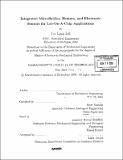| dc.contributor.advisor | Scott Manalis. | en_US |
| dc.contributor.author | Loh, Tzu Liang | en_US |
| dc.contributor.other | Massachusetts Institute of Technology. Dept. of Mechanical Engineering. | en_US |
| dc.date.accessioned | 2006-03-29T18:37:05Z | |
| dc.date.available | 2006-03-29T18:37:05Z | |
| dc.date.copyright | 2005 | en_US |
| dc.date.issued | 2005 | en_US |
| dc.identifier.uri | http://hdl.handle.net/1721.1/32355 | |
| dc.description | Thesis (S.M.)--Massachusetts Institute of Technology, Dept. of Mechanical Engineering, 2005. | en_US |
| dc.description | Includes bibliographical references (leaves 123-125). | en_US |
| dc.description.abstract | Microfluidics, microfabricated suspended heaters and electronic field effect sensors have been successfully integrated on a single device chip. This integration enables spatial cycling of as little as 11nL of reagents over different thermally isolated temperature zones, to be coupled with the field effect sensing capabilities, for label-free detection of biomolecules such as DNA. The microfluidic valves provide control over reagent flow, and flow rates of up to 1.8nLs⁻¹ have been demonstrated with the on-chip pumps. Initial characterization of the suspended heaters was successfully carried out using thermochromic crystals. Functionality of the heaters was shown and a rough calibration was obtained. The subsequent implementation of temperature measurement using fluorescent dyes, enabled real-time spatial temperature mapping. This method demonstrated the capability of monitoring fluid temperatures in microfluidic channels with 5ÌŠC accuracy at 2[mu]m² resolution. Thermal isolation of the suspended heaters was clearly observed from the steep gradients in the spatial temperature profiles captured. Finally, localized boiling of water in the microfluidic channels was achieved, with only 30mW supplied to the heaters. In order to evaluate the sensors, tests were carried out to determine its sensitivity to surface charge. Buffer solutions of different pH were injected, and the sensors have been able to measure pH values ranging from 2.2 - 7.4 and demonstrate sensitivity of up to 38.8mV per pH unit change. Highly charged poly-electrolytes were also investigated as model systems to validate sensor detection of charged biomolecules. | en_US |
| dc.description.abstract | (cont.) The adsorption and layer-by-layer deposition of multiple poly-electrolyte layers to the sensor surface have been successfully detected. This device paves the way for future integration of multiple microfluidic compo- nents, for lab-on-a-chip applications. | en_US |
| dc.description.statementofresponsibility | by Tzu Liang Loh. | en_US |
| dc.format.extent | 125 leaves | en_US |
| dc.format.extent | 5022237 bytes | |
| dc.format.extent | 5028481 bytes | |
| dc.format.mimetype | application/pdf | |
| dc.format.mimetype | application/pdf | |
| dc.language.iso | eng | en_US |
| dc.publisher | Massachusetts Institute of Technology | en_US |
| dc.rights | M.I.T. theses are protected by copyright. They may be viewed from this source for any purpose, but reproduction or distribution in any format is prohibited without written permission. See provided URL for inquiries about permission. | en_US |
| dc.rights.uri | http://dspace.mit.edu/handle/1721.1/7582 | |
| dc.subject | Mechanical Engineering. | en_US |
| dc.title | Integrated microfluidics, heaters, and electronic sensors for Lab-on-a-Chip applications | en_US |
| dc.type | Thesis | en_US |
| dc.description.degree | S.M. | en_US |
| dc.contributor.department | Massachusetts Institute of Technology. Department of Mechanical Engineering | |
| dc.identifier.oclc | 61493803 | en_US |
